The Story of the White City
Reading time: 5 min
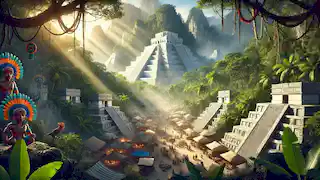
About this story: The Story of the White City is a Legend from United States set in the Ancient This Descriptive tale explores themes of Nature and is suitable for All Ages. It offers Cultural insights. Deep within the lush jungles of Central America lies the forgotten legend of the White City, a Mesoamerican marvel built from gleaming limestone and filled with treasures of gold and jade. Once a thriving hub of culture, knowledge, and power, its fall came under a crimson moon, as foretold by prophecy. Now buried beneath the rainforest, the White City’s ruins whisper of its glory, tragedy, and the resilience of a civilization long lost to time. Discover its story, where myth meets history.
In the dense rainforests of Central America, where jaguars prowled the underbrush and the calls of exotic birds echoed through the towering canopy, a legend whispered from generation to generation: the tale of the White City, a Mesoamerican marvel hidden by nature’s grasp. Known to the locals as "La Ciudad Blanca", it was said to be a city of unimaginable wealth, with walls as luminous as moonlight and temples that kissed the heavens.
The story begins centuries ago, when the city was not a mere legend but a thriving metropolis at the heart of a grand civilization. Built with immaculate white limestone and adorned with carvings that told the stories of gods and heroes, it was a sanctuary for scholars, warriors, and priests. But as time passed, the city fell to ruin, swallowed by the jungle, its secrets waiting to be rediscovered.
The Founding of the White City
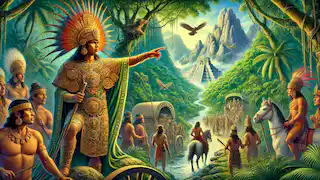
According to the ancient lore passed down by storytellers, the White City was established during an era of celestial upheaval. A great king named Ahau K'inich, guided by a vision from the gods, led his people deep into the uncharted jungles. In his vision, he had seen a place where the rivers converged beneath a sacred mountain, a land blessed with fertile soil and bountiful game. The king decreed this site would become the heart of his kingdom.
The construction of the city was a monumental task. Thousands of laborers, artisans, and architects worked tirelessly under the searing sun, hauling massive stones to create structures of breathtaking precision. The city’s crowning jewel was its Great Temple, whose summit offered an unobstructed view of the cosmos. The people believed this temple connected the heavens and the earth, a bridge for the gods to descend and bless the mortals.
The city grew prosperous, its streets bustling with traders from neighboring lands. Gold, jade, cacao, and exotic feathers changed hands in vibrant markets. The priests, known as the Ah Kin, studied the movements of the stars, refining a calendar more accurate than those of their contemporaries. Art and culture flourished, with vibrant murals and towering stelae chronicling their achievements.
The Golden Age
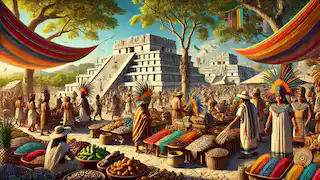
For centuries, the White City thrived as a beacon of ingenuity and wealth. The ruling class, descendants of Ahau K'inich, ensured peace through diplomacy and displays of military strength. The warriors of the White City were unparalleled, their obsidian blades feared by enemies far and wide.
Religious rituals were central to life in the city. Elaborate ceremonies were conducted in honor of Kukulkan, the feathered serpent god, and Chaac, the deity of rain. Offerings of maize, jade, and even human sacrifices were made to secure bountiful harvests and protection from the wrath of nature.
The city also became a center for knowledge. Its libraries housed codices filled with information about agriculture, astronomy, and medicine. Scholars journeyed from distant regions to learn from its priests and scribes, making the White City a hub of intellectual exchange.
The Prophecy of Decline
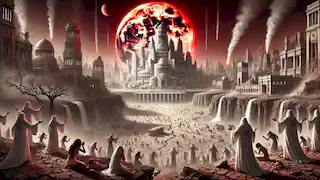
Despite its splendor, a prophecy loomed over the White City, foretelling its eventual fall. According to the Chilam Balam, a sacred text, the city would face destruction when the “moon turned crimson” and the jungle reclaimed what had been taken. For years, this prophecy was dismissed as superstition, but signs of its fulfillment began to emerge.
The first omen came in the form of drought. The once-reliable rains became erratic, and the crops withered. Priests performed desperate ceremonies, but the skies remained unyielding. Starvation and disease spread through the population, weakening the city’s defenses.
As resources dwindled, tensions grew within the ruling elite. Factions vied for power, leading to internal strife. The city’s enemies, sensing vulnerability, began launching raids, and the once-mighty warriors of the White City found themselves overwhelmed.
In the midst of chaos, the priests declared that the gods had abandoned them. The Great Temple, once the heart of their faith, became a site of frenzied rituals as they sought to appease the heavens. But the prophecy’s fulfillment was inevitable.
The Fall of the White City
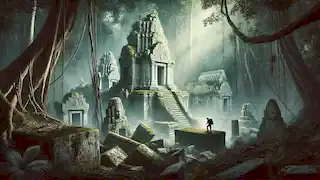
One fateful night, under a blood-red moon, the city was attacked by a coalition of rival kingdoms. The defenders fought valiantly, but the combined forces of hunger, disease, and betrayal proved insurmountable. The invaders breached the city walls, setting fire to its once-glorious buildings. The screams of the dying echoed through the jungle as the White City was reduced to ashes.
In the aftermath, survivors fled into the wilderness, taking with them only fragments of their history. Over time, the jungle claimed what remained, concealing the ruins beneath layers of vines and earth. The White City became a memory, its grandeur preserved only in whispered tales.
Rediscovery and Legacy
Centuries later, explorers armed with machetes and a thirst for adventure ventured into the jungle, guided by local legends. They discovered fragments of the White City—weathered stelae, crumbling temples, and the faint traces of its majestic walls. These discoveries reignited interest in the ancient civilization that once thrived there.
Archaeologists have since uncovered artifacts that provide glimpses into the city’s past: intricate jade jewelry, ceremonial masks, and tools that demonstrate remarkable craftsmanship. Each find adds another piece to the puzzle of the White City, allowing modern historians to reconstruct its story.
Today, the legend of the White City endures as a testament to human resilience and the enduring power of nature. Its ruins, veiled in mystery, remind us of the fragility of even the greatest civilizations and the profound connection between humanity and the environment.










